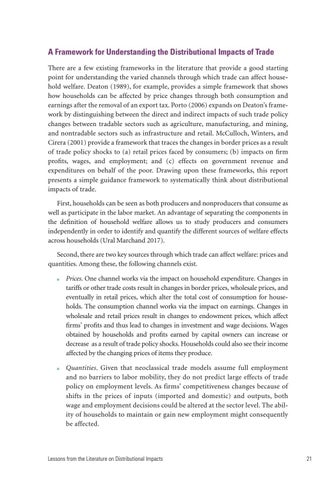A Framework for Understanding the Distributional Impacts of Trade There are a few existing frameworks in the literature that provide a good starting point for understanding the varied channels through which trade can affect household welfare. Deaton (1989), for example, provides a simple framework that shows how households can be affected by price changes through both consumption and earnings after the removal of an export tax. Porto (2006) expands on Deaton’s framework by distinguishing between the direct and indirect impacts of such trade policy changes between tradable sectors such as agriculture, manufacturing, and mining, and nontradable sectors such as infrastructure and retail. McCulloch, Winters, and Cirera (2001) provide a framework that traces the changes in border prices as a result of trade policy shocks to (a) retail prices faced by consumers; (b) impacts on firm profits, wages, and employment; and (c) effects on government revenue and expenditures on behalf of the poor. Drawing upon these frameworks, this report presents a simple guidance framework to systematically think about distributional impacts of trade. First, households can be seen as both producers and nonproducers that consume as well as participate in the labor market. An advantage of separating the components in the definition of household welfare allows us to study producers and consumers independently in order to identify and quantify the different sources of welfare effects across households (Ural Marchand 2017). Second, there are two key sources through which trade can affect welfare: prices and quantities. Among these, the following channels exist. ■■
■■
Prices. One channel works via the impact on household expenditure. Changes in tariffs or other trade costs result in changes in border prices, wholesale prices, and eventually in retail prices, which alter the total cost of consumption for households. The consumption channel works via the impact on earnings. Changes in wholesale and retail prices result in changes to endowment prices, which affect firms’ profits and thus lead to changes in investment and wage decisions. Wages obtained by households and profits earned by capital owners can increase or decrease as a result of trade policy shocks. Households could also see their income affected by the changing prices of items they produce. Quantities. Given that neoclassical trade models assume full employment and no barriers to labor mobility, they do not predict large effects of trade policy on employment levels. As firms’ competitiveness changes because of shifts in the prices of inputs (imported and domestic) and outputs, both wage and employment decisions could be altered at the sector level. The ability of households to maintain or gain new employment might consequently be affected.
Lessons from the Literature on Distributional Impacts 21

